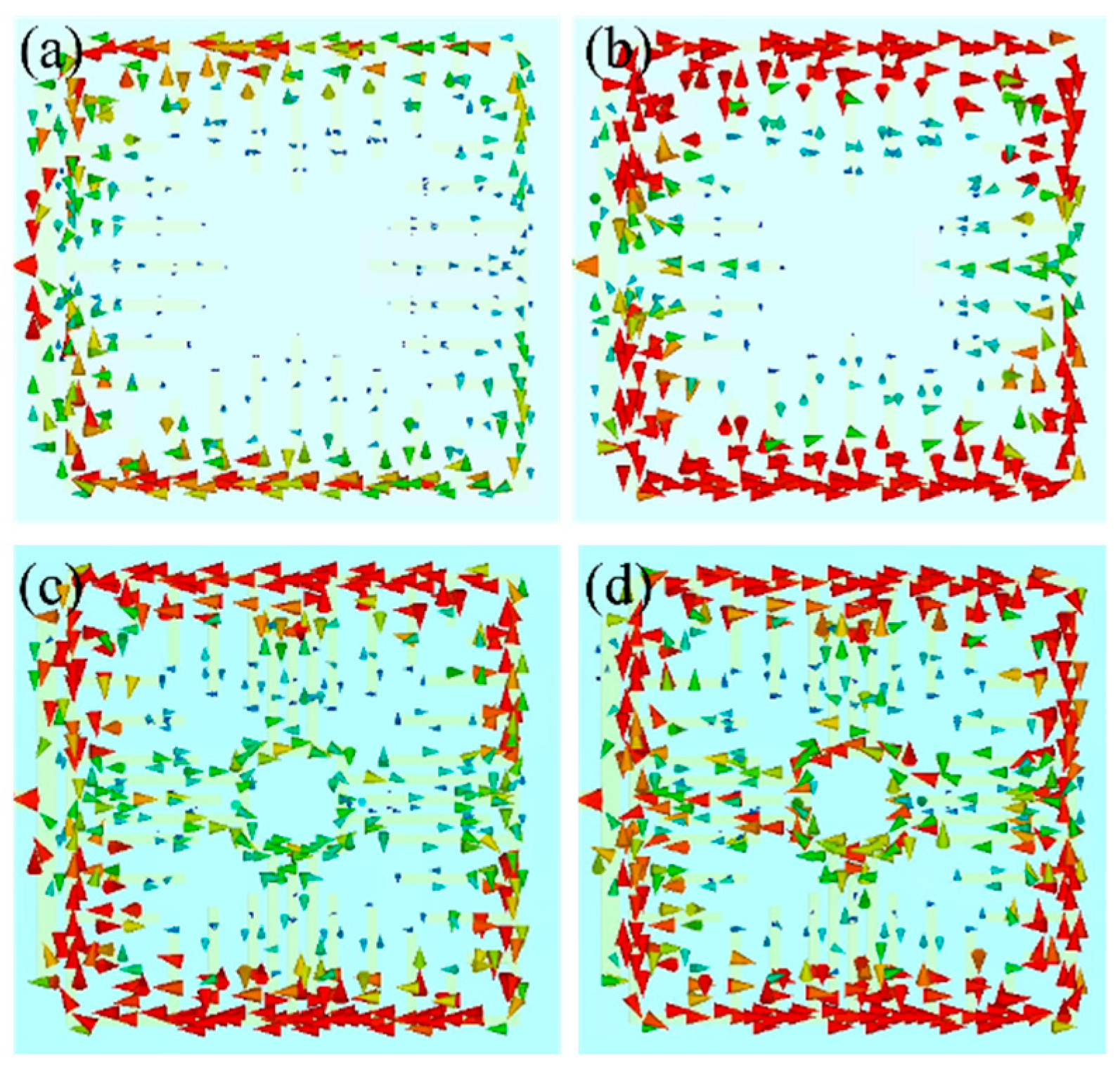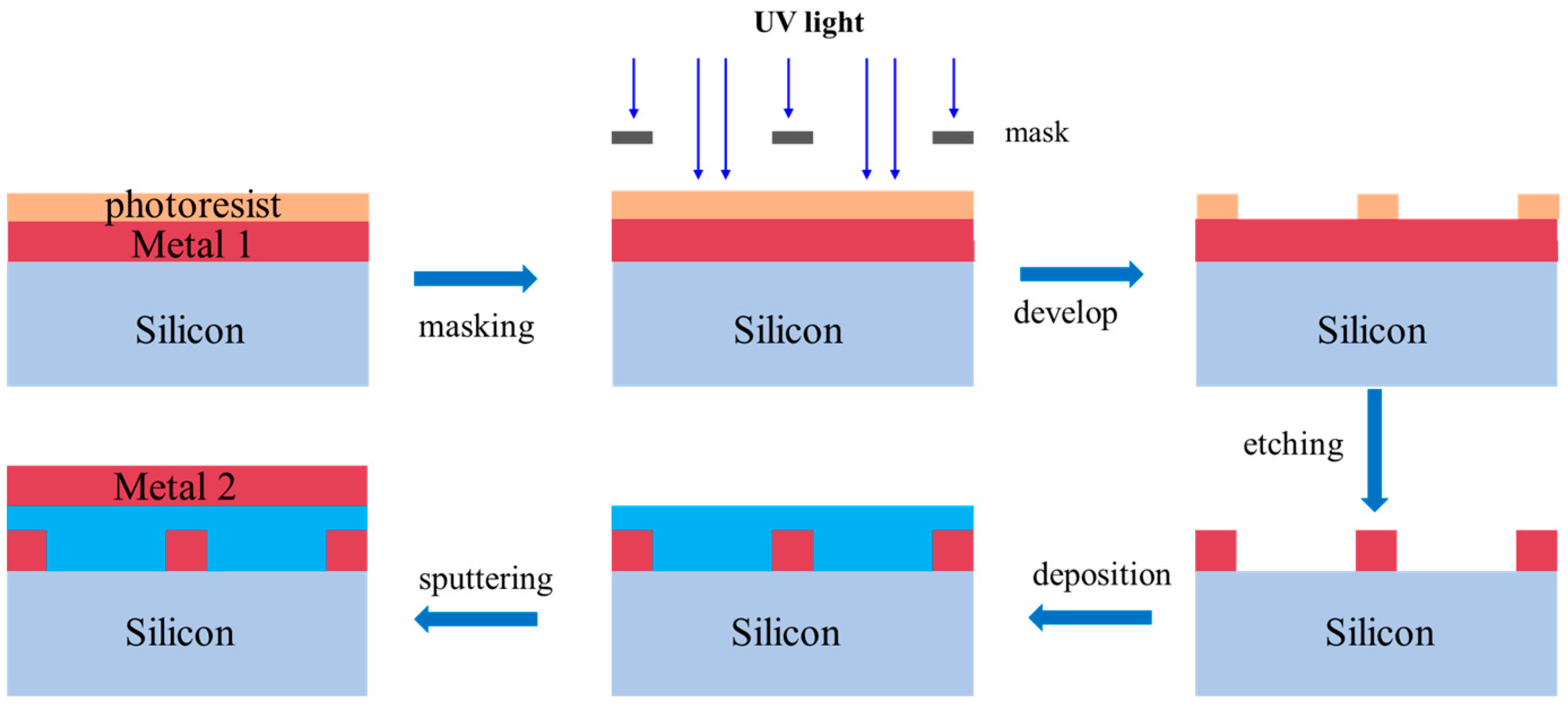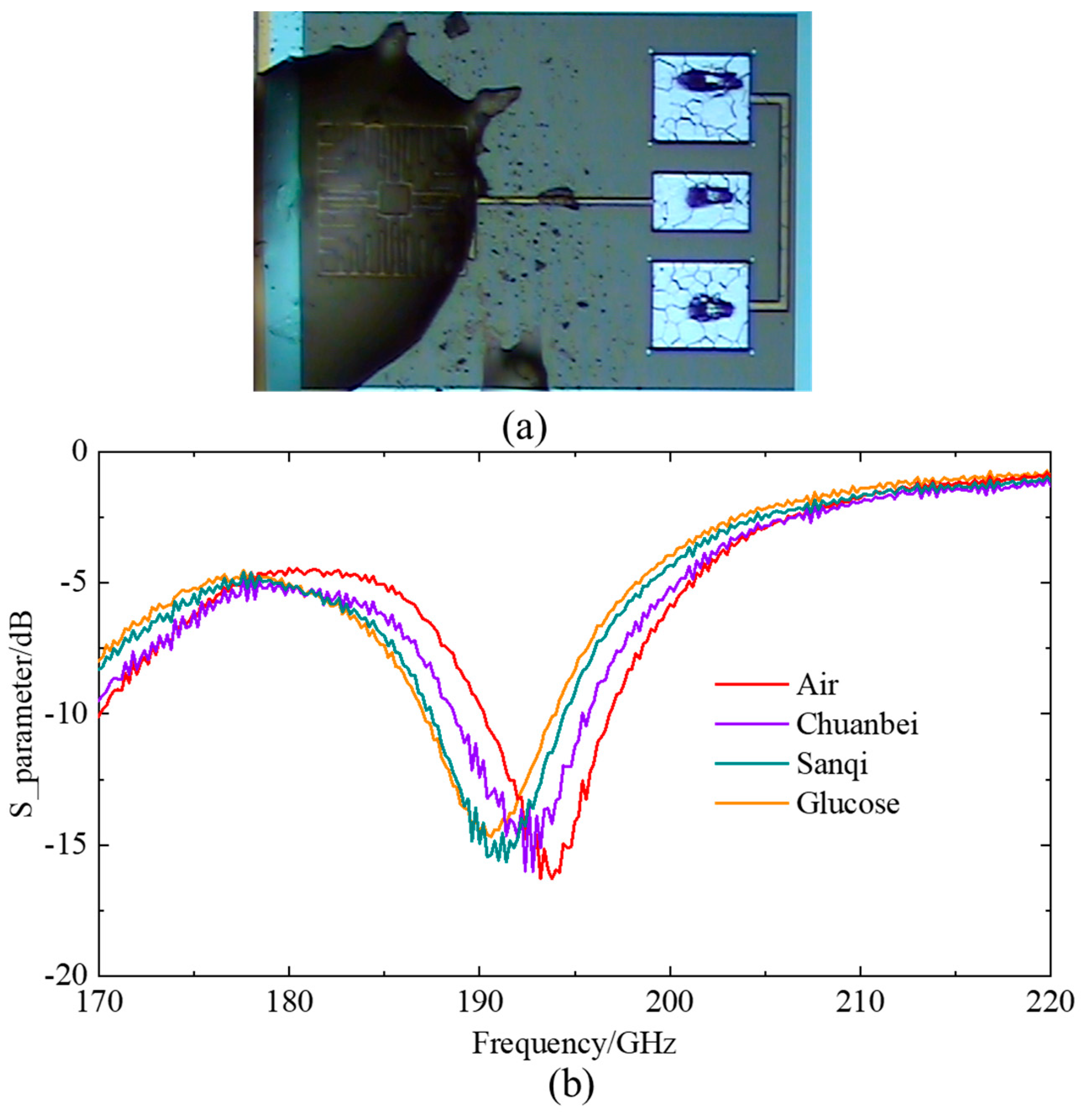Terahertz CMOS High-Sensitivity Sensor Based on Hybridized Spoof Surface Plasmon Resonator
Abstract
1. Introduction
2. Designs and Simulations
3. Sensing Simulation
4. Experimental Results
5. Conclusions
Author Contributions
Funding
Data Availability Statement
Acknowledgments
Conflicts of Interest
References
- Qin, J.; Jiang, S.; Wang, Z.; Cheng, X.; Li, B.; Shi, Y.; Tsai, D.P.; Liu, A.Q.; Huang, W.; Zhu, W. Metasurface Micro/Nano-Optical Sensors: Principles and Applications. ACS Nano 2022, 16, 11598–11618. [Google Scholar] [CrossRef] [PubMed]
- Owji, E. 2D Materials Coated on Etched Optical Fibers as Humidity Sensor. Sci. Rep. 2021, 11, 1771. [Google Scholar] [CrossRef] [PubMed]
- Xu, Y.; Bai, P.; Zhou, X.; Akimov, Y.; Png, C.E.; Ang, L.-K.; Knoll, W.; Wu, L. Optical Refractive Index Sensors with Plasmonic and Photonic Structures: Promising and Inconvenient Truth. Adv. Opt. Mater. 2019, 7, 1801433. [Google Scholar] [CrossRef]
- Shin, J.; Liu, Z.; Bai, W.; Liu, Y.; Yan, Y.; Xue, Y.; Kandela, I.; Pezhouh, M.; MacEwan, M.R.; Huang, Y.; et al. Bioresorbable Optical Sensor Systems for Monitoring of Intracranial Pressure and Temperature. Sci. Adv. 2019, 5, eaaw1889. [Google Scholar] [CrossRef] [PubMed]
- Su, J.; Goldberg, A.F.; Stoltz, B.M. Label-Free Detection of Single Nanoparticles and Biological Molecules Using Microtoroid Optical Resonators. Light Sci. Appl. 2016, 5, e16001. [Google Scholar] [CrossRef]
- Prabowo, B.; Purwidyantri, A.; Liu, K.-C. Surface Plasmon Resonance Optical Sensor: A Review on Light Source Technology. Biosensors 2018, 8, 80. [Google Scholar] [CrossRef]
- Zhang, X.; Cui, W.Y.; Lei, Y.; Zheng, X.; Zhang, J.; Cui, T.J. Spoof Localized Surface Plasmons for Sensing Applications. Adv. Mater. Technol. 2021, 6, 2000863. [Google Scholar] [CrossRef]
- Liao, Z.; Liu, S.; Ma, H.F.; Li, C.; Jin, B.; Cui, T.J. Electromagnetically Induced Transparency Metamaterial Based on Spoof Localized Surface Plasmons at Terahertz Frequencies. Sci. Rep. 2016, 6, 27596. [Google Scholar] [CrossRef] [PubMed]
- Liang, Y.; Yu, H.; Zhang, H.C.; Yang, C.; Cui, T.J. On-Chip Sub-Terahertz Surface Plasmon Polariton Transmission Lines in CMOS. Sci. Rep. 2015, 5, 14853. [Google Scholar] [CrossRef]
- Shang, Y.; Yu, H.; Hu, S.; Liang, Y.; Bi, X.; Arasu, M.A. High-Sensitivity CMOS Super-Regenerative Receiver with Quench-Controlled High-$Q$ Metamaterial Resonator for Millimeter-Wave Imaging at 96 and 135 GHz. IEEE Trans. Microw. Theory Technol. 2014, 62, 3095–3106. [Google Scholar] [CrossRef]
- Gao, X.; Chen, B.J.; Shum, K.; Ma, Q.; Cui, W.Y.; Cui, T.J.; Chan, C.H. Multifunctional Terahertz Spoof Plasmonic Devices. Adv. Mater. Technol. 2023, 8, 2202050. [Google Scholar] [CrossRef]
- Zhang, H.C.; Zhang, Q.; Liu, J.F.; Tang, W.; Fan, Y.; Cui, T.J. Smaller-Loss Planar SPP Transmission Line than Conventional Microstrip in Microwave Frequencies. Sci. Rep. 2016, 6, 23396. [Google Scholar] [CrossRef] [PubMed]
- Dong, G.; Shen, Y.; Hu, S. On-Chip Localized Surface Plasmon Resonator for 127 GHz Compact CMOS Oscillator. IEEE Electron Device Lett. 2023, 44, 1927–1930. [Google Scholar] [CrossRef]
- Thapa, S.K.; Pokharel, R.K.; Chen, B.; Barakat, A. On-Chip Millimeter-Wave DGS Based Bandstop Filter in 0.18-μm CMOS Process. IEEE Trans. Circuits Syst. II 2022, 69, 2732–2736. [Google Scholar] [CrossRef]
- Harmankaya, S.; Deveci, H.A.; Harmankaya, A.; Gül, F.H.; Atar, N.; Yola, M.L. Thiram Determination in Milk Samples by Surface Plasmon Resonance Based on Molecularly Imprinted Polymers and Sulphur-Doped Titanium Dioxide. Biosensors 2024, 14, 329. [Google Scholar] [CrossRef] [PubMed]
- Pesavento, M.; Zeni, L.; Maria, L.D.; Alberti, G.; Cennamo, N. SPR-Optical Fiber-Molecularly Imprinted Polymer Sensor for the Detection of Furfural in Wine. Biosensors 2021, 11, 72. [Google Scholar] [CrossRef]
- Pors, A.; Moreno, E.; Martin-Moreno, L.; Pendry, J.B.; Garcia-Vidal, F.J. Localized Spoof Plasmons Arise While Texturing Closed Surfaces. Phys. Rev. Lett. 2012, 108, 223905. [Google Scholar] [CrossRef] [PubMed]
- Liao, Z.; Luo, Y.; Fernández-Domínguez, A.I.; Shen, X.; Maier, S.A.; Cui, T.J. High-Order Localized Spoof Surface Plasmon Resonances and Experimental Verifications. Sci. Rep. 2015, 5, 9590. [Google Scholar] [CrossRef] [PubMed]
- Gholamian, M.; Shabanpour, J.; Cheldavi, A. Highly Sensitive Quarter-Mode Spoof Localized Plasmonic Resonator for Dual-Detection RF Microfluidic Chemical Sensor. J. Phys. D Appl. Phys. 2020, 53, 145401. [Google Scholar] [CrossRef]
- Zhang, X.; Cui, T.J. Contactless Glucose Sensing at Sub-Micromole Level Using a Deep-Subwavelength Decimeter-Wave Plasmonic Resonator. Laser Photonics Rev. 2022, 16, 2200221. [Google Scholar] [CrossRef]
- Luo, C.; Chen, L. Highly Sensitive and Tunable Absorption-Induced Transparency for Terahertz Fingerprint Sensing with Spoof Surface Plasmon Polaritons. IEEE Sens. J. 2024, 24, 17686–17692. [Google Scholar] [CrossRef]
- Yang, B.J.; Zhou, Y.J.; Xiao, Q.X. Spoof Localized Surface Plasmons in Corrugated Ring Structures Excited by Microstrip Line. Opt. Express OE 2015, 23, 21434–21442. [Google Scholar] [CrossRef]
- Liao, Z.; Pan, B.C.; Shen, X.; Cui, T.J. Multiple Fano Resonances in Spoof Localized Surface Plasmons. Opt. Express 2014, 22, 15710. [Google Scholar] [CrossRef] [PubMed]
- Shen, X.; Cui, T.J. Ultrathin Plasmonic Metamaterial for Spoof Localized Surface Plasmons: Spoof Localized Surface Plasmons. Laser Photonics Rev. 2014, 8, 137–145. [Google Scholar] [CrossRef]
- Kim, Y.; Salim, A.; Lim, S. Millimeter-Wave-Based Spoof Localized Surface Plasmonic Resonator for Sensing Glucose Concentration. Biosensors 2021, 11, 358. [Google Scholar] [CrossRef]
- Zhou, J.; Chen, L.; Sun, Q.; Liao, D.; Ding, L.; Balakin, A.V.; Shkurinov, A.P.; Xie, J.; Zang, X.; Cheng, Q.; et al. Terahertz On-Chip Sensing by Exciting Higher Radial Order Spoof Localized Surface Plasmons. Appl. Phys. Express 2020, 13, 012014. [Google Scholar] [CrossRef]
- Wang, J.; Zhang, J.; Gao, H.; Fu, X.; Bao, D.; Cui, T.J. Mixed-Resolution High-Q Sensor Based on Hybridized Spoof Localized Surface Plasmons. Front. Phys. 2022, 10, 850186. [Google Scholar] [CrossRef]
- Bao, D.; Cheng, Q.; Jiang, W.X.; Zhang, J.J.; Liao, Z.; Wu, J.W.; Yang, J.; Zhang, X.R.; Cui, T.J. Concentric Designer Plasmon Hybridization in Deep Subwavelength Metamaterial Resonator. Appl. Phys. Lett. 2019, 115, 121103. [Google Scholar] [CrossRef]
- Su, H.; Shen, X.; Su, G.; Li, L.; Ding, J.; Liu, F.; Zhan, P.; Liu, Y.; Wang, Z. Efficient Generation of Microwave Plasmonic Vortices via a Single Deep-Subwavelength Meta-Particle. Laser Photonics Rev. 2018, 12, 1800010. [Google Scholar] [CrossRef]










| Dielectric | Thickness (μm) | Relative Permittivity |
|---|---|---|
| PASS3 | 0.6 | 7.9 |
| PASS2 | 0.15 | 4.15 |
| PASS1 | 3.6 | 4.15 |
| DIEL_METAL6 | 4.7 | 3.8 |
| DIEL_CTM_VIA | 0.88 | 3.83 |
| IMD5A | 0.55 | 3.7 |
| IMD (4A-1A) | 0.615 | 3.7 |
| DIEL_VIA (4-1) | 0.765 | 3.819 |
| ILD2 | 0.5 | 4 |
| ILD1 | 0.25 | 4 |
| FOX | 0.35 | 3.9 |
Disclaimer/Publisher’s Note: The statements, opinions and data contained in all publications are solely those of the individual author(s) and contributor(s) and not of MDPI and/or the editor(s). MDPI and/or the editor(s) disclaim responsibility for any injury to people or property resulting from any ideas, methods, instructions or products referred to in the content. |
© 2025 by the authors. Licensee MDPI, Basel, Switzerland. This article is an open access article distributed under the terms and conditions of the Creative Commons Attribution (CC BY) license (https://creativecommons.org/licenses/by/4.0/).
Share and Cite
Wan, M.; Li, C.; Bao, D.; Wang, J.; Lu, K.; Qu, Z.; Gao, H. Terahertz CMOS High-Sensitivity Sensor Based on Hybridized Spoof Surface Plasmon Resonator. Photonics 2025, 12, 102. https://doi.org/10.3390/photonics12020102
Wan M, Li C, Bao D, Wang J, Lu K, Qu Z, Gao H. Terahertz CMOS High-Sensitivity Sensor Based on Hybridized Spoof Surface Plasmon Resonator. Photonics. 2025; 12(2):102. https://doi.org/10.3390/photonics12020102
Chicago/Turabian StyleWan, Ming, Chenchen Li, Di Bao, Jiangpeng Wang, Kai Lu, Zhenyu Qu, and Hao Gao. 2025. "Terahertz CMOS High-Sensitivity Sensor Based on Hybridized Spoof Surface Plasmon Resonator" Photonics 12, no. 2: 102. https://doi.org/10.3390/photonics12020102
APA StyleWan, M., Li, C., Bao, D., Wang, J., Lu, K., Qu, Z., & Gao, H. (2025). Terahertz CMOS High-Sensitivity Sensor Based on Hybridized Spoof Surface Plasmon Resonator. Photonics, 12(2), 102. https://doi.org/10.3390/photonics12020102





